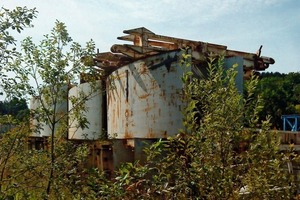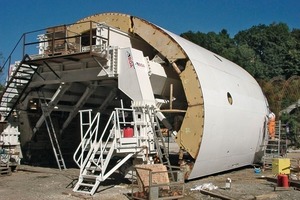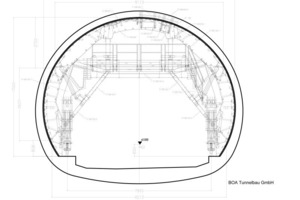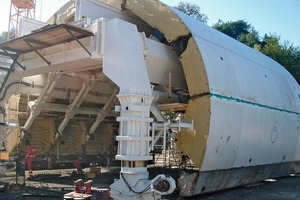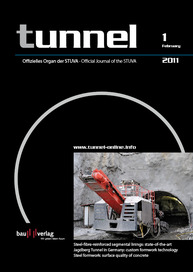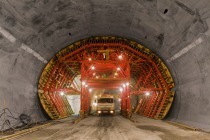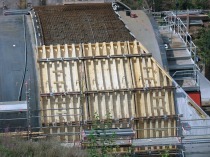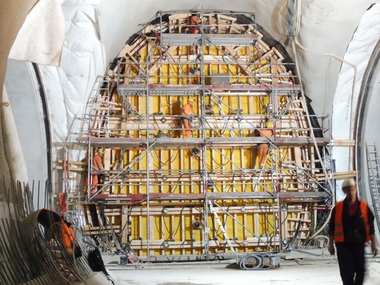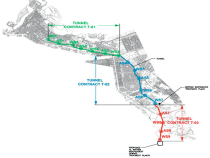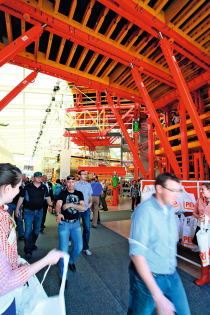Surface quality of concrete using steel formwork
The achievement of the most homogenous and pore-free concrete surface possible is vital for the durability of the structure when installing an inner tunnel lining. The following article illustrates how the use of the latest technology makes it possible to permanently improve surface quality.
It is of great importance for the durability of the inner tunnel lining that the concrete surface achieved should be as homogenous and pore-free as possible. The quality of the concrete is influenced essentially by the concrete formulation, its application, its curing and the type and quality of the formwork facing, with tunnel and gallery engineering primarily employing steel formwork systems.
In October 2009, BOA Tunnelbau GmbH was commissioned by the tunnel-construction department of Baresel GmbH for inspection and subsequent repair of an already multiply used arched-formwork carriage for the Ettendorf Tunnel, Traunstein. This formwork carriage had already been converted once and adapted to the tunnel profile.
In view of the only slight difference between the transverse profile of the Ettendorf Tunnel to be constructed and the arched-formwork carriage, the contractor performing the works had planned to line the steel formwork facing with a plastic formwork facing. The formwork manufacturer submitted the alternative proposal of performing the profile adjustment on the load-bearing elements and the steel formwork, and then coating the entire steel formwork after completion of this work.
The arched-formwork carriage had previously been dismantled and stored in the open air for years, and was in a corresponding state. It exhibited massive corrosion damage, despite a protective coating applied to the steel formwork facing. The unprotected elements of the formwork carriage manifested even more severe corrosion, including rusting through in isolated cases (Figure 1).
It was decided during the inspection to have the complete steel formwork facing sand-blasted by a specialist company in a corresponding workshop; this operation would have been extremely difficult on the site. All the other components, such as the equipment car, running gear, cylinders, platforms, work stands, etc., were shipped directly to the new working location. Selection of a suitable coating for the steel formwork facing was then the next task.
BOA Tunnelbau GmbH has for a number of years been working on improving the quality of the concrete installed in tunnel structures and, in particular, the amount of air pores in the negative zone of the inner lining. Tests using various formwork release agents and concrete formulations not having produced the desired results, attention then focused, in the case of the Ettendorf Tunnel, on the formwork facing surface.
As is generally appreciated in tunnel engineering, cleaning of the formwork facing of an arched-formwork carriage is both difficult and time-consuming. If, in addition, the inner lining is also reinforced - as in the Ettendorf Tunnel - there is only very little working space available in the side wall zone and the tunnel crown. Cleaning is then performed mechanically, and using scrapers, in the gap in the reinforcement and through the concreting windows. Sub-standard points on the ultimate concrete surface are inevitable since, depending on the configuration of the concreting windows, it is frequently not possible to reach all areas. The surface of any finished concrete is and always remains the mirror image of the formwork facing, and can be modified only by means of various treatments or coatings.
Self-cleaning surfaces are of increasing technical and economic significance in many fields. A fouling-repelling surface can be created by decreasing the surface‘s adhesion, with the benefit that dirt particles can be more easily washed off and removed during subsequent cleaning. But how is this reduction of adhesion on such surfaces to be achieved? There are two possibilities: modification of surface tension, on the one hand, and modification of the surface texture, on the other.
Reducing surface tension causes the surface to have a lower wettability - the so-called „lotus effect“, a term which derives from the lotus flower, from which water runs off, entraining and removing dirt particles on the surface in the process. The complex microscopic and nanoscopic architecture of the surface is responsible for this, since it minimises adhesion. As the lotus effect is based entirely on chemical and physical structures, and has no organic component, it is also possible to create artificial self-cleaning surfaces without difficulty.
Nano-sealing can be used to modify the surface structure of the most diverse materials and achieve surface improvement in terms of resistance to water, fats, oils and other fouling particles. Nano-sealing is, in principle, a refinement of the lotus effect.
A nano-sealant is based on an extremely smooth surface and enters a permanent chemical bond with it. Nanoparticles are less than 100 nm in size, and seal the surface by accumulating on it. The sealing effect results because other materials, such as water, dust, etc., are no longer able to accumulate on the surface, and therefore run off. Detachment of the nano-coating from porous surfaces is practically impossible, and is possible on smooth surfaces only with considerable mechanical effort. The end result is that a coating of this type is virtually ideal for severely fouled surfaces, such as that of a steel formwork facing. A number of materials now make it possible to produce coatings which possess not only hydrophobic but also oleophobic properties, i.e., both water and oils run off without difficulty on such coated surfaces (Figure 2).
More or less severe pore-formation on the concrete surface, with the consequence of increased overall porosity, occurs again and again in the creation of the vaulted inner lining of a tunnel. It is for practical purposes impossible, particularly in the negative bottom zone of the formwork, to expel the air trapped between the formwork facing and the concrete to the surface, and thus out of the concrete, by means of the energy of compaction applied. The formwork itself acts here like a seal. If the surface is coated in such a way as to reduce surface tension, however, the air inclusions can more easily escape upward during compaction of the concrete. The result is a significantly lower porosity in the finished concrete surface (Figure 3).
In the case of the Ettendorf Tunnel Traunstein project, BOA Tunnelbau GmbH decided, following discussions with various producers, and in co-ordination with Baresel GmbH, in favour of a coating consisting of a two-component („two-pack“) paint system on a polysiloxane-polyepoxide resin basis, an AM Surface product. This two-component paint system is resistant to frost, de-icing salts and chemicals, and also has high mechanical strength. It possesses, in addition, excellent cleanability and adhesion, even on matt-moist substrates. It can be applied either using rollers or airless systems. Curing is not necessary. The substrate in the Ettendorf Tunnel was carefully prepared, and all irregularities were either ground off or filled (Figure 4).
After completion of more than fifteen concreted roof elements, the coating remains in an extremely good condition, despite exposure in some cases to high mechanical loads caused by the reinforcement. Above the negative zone, porosity has disappeared completely, and has been significantly reduced in the negative zone itself. The concrete surface exhibits a homogenous and uniform structure and coloration.
The cleaning-time input following concreting has also been greatly reduced. We can ascertain, by way of conclusion, that the decision to coat the steel formwork using nano-technology was the best course of action for this project. The improved quality of the concrete at its surface, combined with the lower cleaning input, will ensure that coatings based on nano-technology will increasingly be used in the future.

